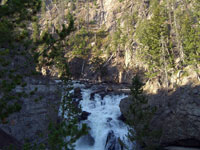 These first three pictures take a look at the Firehose River running through a canyon.
These first three pictures take a look at the Firehose River running through a canyon.  As the river bed got smaller the water pressure increased really representing the power of water.
As the river bed got smaller the water pressure increased really representing the power of water.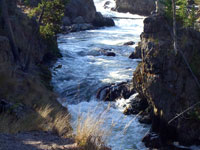 We were wondering as we looked down from the top of the canyon if anyone was willing to kayak down this section.
We were wondering as we looked down from the top of the canyon if anyone was willing to kayak down this section.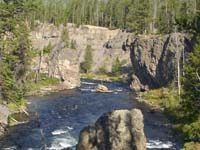 I thought this was a nice peaceful picture of the river after it came through the canyon.
I thought this was a nice peaceful picture of the river after it came through the canyon.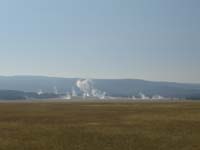 As we made our way from Lower Geyser Basin to Middle Geyser Basin and finally to Upper Geyser Basin, the road passed along this open field where you could see all the steam rising from the thermals.
As we made our way from Lower Geyser Basin to Middle Geyser Basin and finally to Upper Geyser Basin, the road passed along this open field where you could see all the steam rising from the thermals. Obviously, this thermal has been active for awhile. There was no getting close to this one since it is not recommended to go out on the thin mineral deposit crust.
Obviously, this thermal has been active for awhile. There was no getting close to this one since it is not recommended to go out on the thin mineral deposit crust.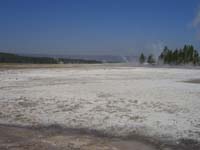 This is looking out at the Middle Basin Geyser.
This is looking out at the Middle Basin Geyser. The differnt colors are caused by the different temperature in the water and the bacteria that can live in water at that temperature. These are called bacteria mats.
The differnt colors are caused by the different temperature in the water and the bacteria that can live in water at that temperature. These are called bacteria mats. I was attempting to capture the blueness of the water, but since it was earlier in the morning, the steam continued to get in the way.
I was attempting to capture the blueness of the water, but since it was earlier in the morning, the steam continued to get in the way.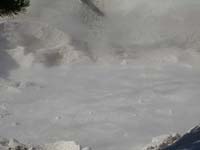 The infamous mud pots. It is really neat to see this mud just flopping around.
The infamous mud pots. It is really neat to see this mud just flopping around.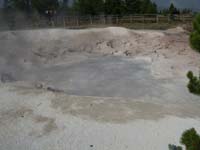 Another view of the mud pots. Based on how much water the pots have in them, the mud pots could be more or less active..
Another view of the mud pots. Based on how much water the pots have in them, the mud pots could be more or less active.. This one is called Spasm Geyser. It is continually throwing water up 5 or 6 feet.
This one is called Spasm Geyser. It is continually throwing water up 5 or 6 feet.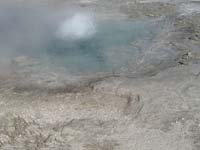 This is a neat picture of the water boiling, the mineral deposits surrounding it and the clear blue water.
This is a neat picture of the water boiling, the mineral deposits surrounding it and the clear blue water.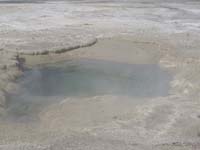 This one has cooler water so you can see the hole that goes down to the source. Ever wonder how deep it is and where it goes? Are they all tied together underneath?
This one has cooler water so you can see the hole that goes down to the source. Ever wonder how deep it is and where it goes? Are they all tied together underneath?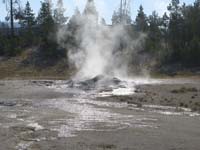 This one periodically throws water out and it cools fast enough to begin building a dome around itself.
This one periodically throws water out and it cools fast enough to begin building a dome around itself.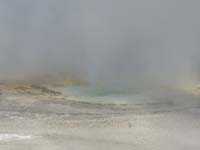 Still can't get a good picture of how blue the water is, but notice the steam hides the everything behind this thermal.
Still can't get a good picture of how blue the water is, but notice the steam hides the everything behind this thermal.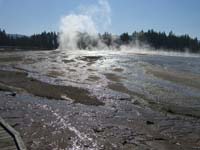 This whole area was covered with the boiling hot water flowing down towards the Firehole River.
This whole area was covered with the boiling hot water flowing down towards the Firehole River.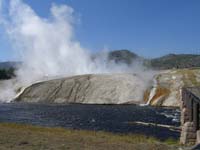 This is where all the water ends up. Flowing into the Firehose River.
This is where all the water ends up. Flowing into the Firehose River.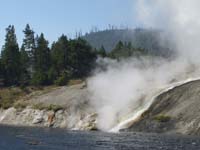 It is really cool to see the steaming water go straight into the river. Due to the warmth in the river, there was a tremoundous amount of algae growing in the river.
It is really cool to see the steaming water go straight into the river. Due to the warmth in the river, there was a tremoundous amount of algae growing in the river.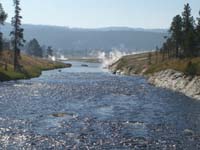 Looking upstream the river, you can see all the thermals that are dumping their water into the river.
Looking upstream the river, you can see all the thermals that are dumping their water into the river.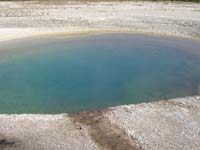 From here there is not much to say other then all thermals and geysers take on different characteristics.
From here there is not much to say other then all thermals and geysers take on different characteristics.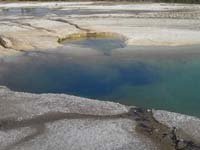 One thermal could be so hot that the water is bubbling out of the pool and ten feet away there is a nice quiet pool.
One thermal could be so hot that the water is bubbling out of the pool and ten feet away there is a nice quiet pool.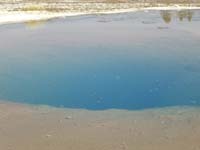 The water is so blue in a lot of the geysers. You would think they would be clouded based on the sulphur smell coming out of them.
The water is so blue in a lot of the geysers. You would think they would be clouded based on the sulphur smell coming out of them.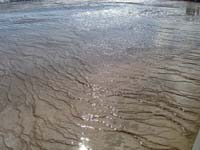 I though this ripple effect from the water cooling and deposits building up was neat with the reflection of the sun.
I though this ripple effect from the water cooling and deposits building up was neat with the reflection of the sun.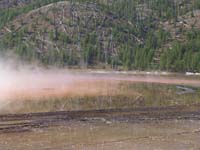 The out skirts of this thermal was so still that it looked like glass.
The out skirts of this thermal was so still that it looked like glass.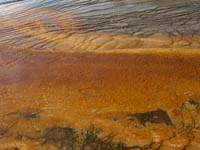 As each thermal had its own characteristics, so did the flow of water from those thermals.
As each thermal had its own characteristics, so did the flow of water from those thermals.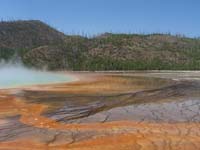 This is a look further back of the glass coming off Emerald Geyser.
This is a look further back of the glass coming off Emerald Geyser.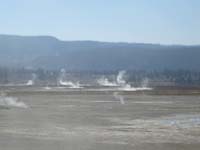 Looking out over the horizon, you can see the thermals/geysers all over the place.
Looking out over the horizon, you can see the thermals/geysers all over the place.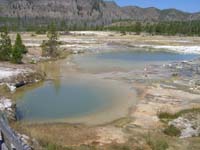 This was in Biscuit Basin for all the biscuit looking rocks that were expelled here.
This was in Biscuit Basin for all the biscuit looking rocks that were expelled here.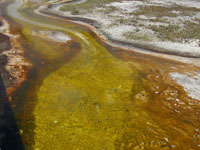 This was by far the most extravagent set of colors from the water run off.
This was by far the most extravagent set of colors from the water run off.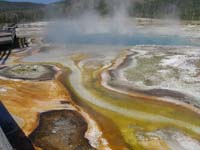 This is a bigger picture of the run off from the picture before. Notice how blue the water is in the thermal.
This is a bigger picture of the run off from the picture before. Notice how blue the water is in the thermal. This is that pool. This was probably the best shot of the blueness in the water.
This is that pool. This was probably the best shot of the blueness in the water. In Georgia this would be called sewage.
In Georgia this would be called sewage.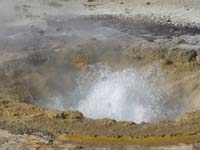 I caught this geyser as it was throwing water out of its crater.
I caught this geyser as it was throwing water out of its crater.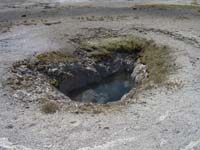 Within 10ft of the geyser erupting in the picture before this one. You have to believe that are tied together, but such different behavoirs.
Within 10ft of the geyser erupting in the picture before this one. You have to believe that are tied together, but such different behavoirs. This is an Anemone Geyser. Every now and then it will throughout water then settle back down deep into its crevasse.
This is an Anemone Geyser. Every now and then it will throughout water then settle back down deep into its crevasse.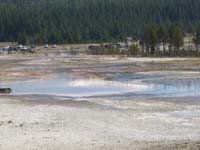 Again, this run off has that glassed over look.
Again, this run off has that glassed over look.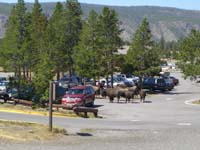 When we got to the Upper Basin Geyser area, it seemed that the Bison were in control.
When we got to the Upper Basin Geyser area, it seemed that the Bison were in control.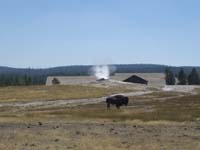 A lone Bison with Old Faithful in the background.
A lone Bison with Old Faithful in the background.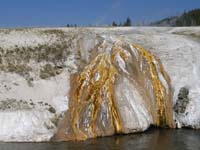 This is looking up at Geyser Hill where the runoff is going into the Firehose River.
This is looking up at Geyser Hill where the runoff is going into the Firehose River. I really thought this was a neat looking thermal. Looks like a great place for a swim.
I really thought this was a neat looking thermal. Looks like a great place for a swim. Beehive Geyser. Really neat cone, but what we did not know was the force that comes out of that cone. You will see in pictures further down the page.
Beehive Geyser. Really neat cone, but what we did not know was the force that comes out of that cone. You will see in pictures further down the page.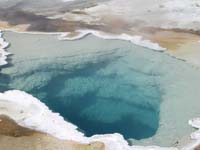 I think this one is called Beauty Pool.
I think this one is called Beauty Pool. Here is Old Faithful getting started from a different view point.
Here is Old Faithful getting started from a different view point. 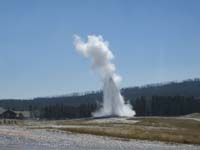 Form this view point of Old Faithful, it is easier to see the water because the steam was being blown another way.
Form this view point of Old Faithful, it is easier to see the water because the steam was being blown another way.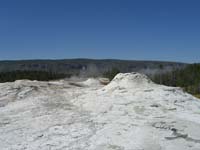 This is called the Lion Group. I guess because of the numerous thermals all together on the same mound.
This is called the Lion Group. I guess because of the numerous thermals all together on the same mound.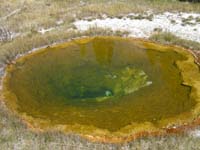 Liberty Pool, I guess it has the color and look of the liberty bell.
Liberty Pool, I guess it has the color and look of the liberty bell.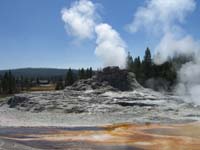 Castle Geyser. This was one of my favorite because of the cone that it had built up.
Castle Geyser. This was one of my favorite because of the cone that it had built up.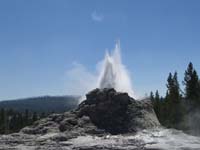 Castle Geyser. Apparently, it used to erupt on regular intervals, but does not anymore.
Castle Geyser. Apparently, it used to erupt on regular intervals, but does not anymore.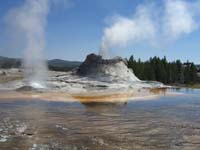 Castle Geyser also has that glassed over looked. Notice the reflection of the cone in the water.
Castle Geyser also has that glassed over looked. Notice the reflection of the cone in the water.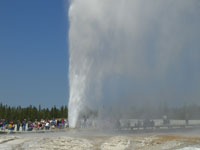 Here is Beehive erupting. It can shoot up to 180ft in the are and lasts for 4 or 5 minutes.
Here is Beehive erupting. It can shoot up to 180ft in the are and lasts for 4 or 5 minutes.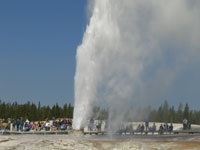 When Beehive is at its peak it really sounds like a jet engine. You would think that it would blow its cone off, but it never does.
When Beehive is at its peak it really sounds like a jet engine. You would think that it would blow its cone off, but it never does.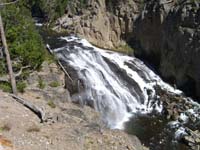 On our way to the Grand Canyon of Yellowstone we stopped for a look at Gibbons Falls.
On our way to the Grand Canyon of Yellowstone we stopped for a look at Gibbons Falls.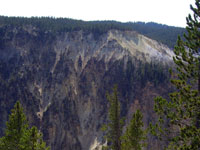 The walls of the Grand Canyon just dropped off with magnifigent colors.
The walls of the Grand Canyon just dropped off with magnifigent colors.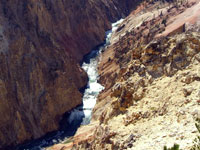 You can see the gulley that the river has cut out of the softrock over the decades.
You can see the gulley that the river has cut out of the softrock over the decades.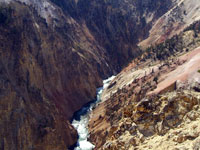 According to some of the information that we read, there are still some active geysers along the walls of the canyon.
According to some of the information that we read, there are still some active geysers along the walls of the canyon.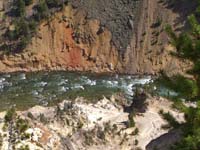 This picture does not give the perspective of just how high we were from the river, but I thought I would try.
This picture does not give the perspective of just how high we were from the river, but I thought I would try. You can see that most of the land here is a plateau and this canyon dug right through it.
You can see that most of the land here is a plateau and this canyon dug right through it.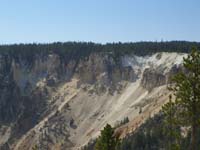 Not sure if the pictures will really show just how dramitc the color was coming off the sides of this canyon.
Not sure if the pictures will really show just how dramitc the color was coming off the sides of this canyon.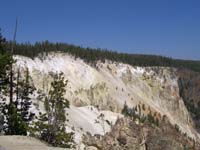 We were able to get the afternoon sun on the sides really enhancing the color.
We were able to get the afternoon sun on the sides really enhancing the color.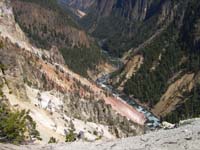 This is a look down the canyon as the river runs through it. This is the Yellowstone River.
This is a look down the canyon as the river runs through it. This is the Yellowstone River. Osprey create their huge nests in the trees right on the edge of these cliffs. Safe from predators.
Osprey create their huge nests in the trees right on the edge of these cliffs. Safe from predators.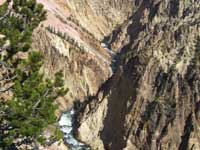 Maybe this is a better perspective of how high we were.
Maybe this is a better perspective of how high we were.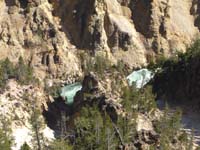 On one of these spires we saw a couple of young Osprey. It looked like they were trying to figure out how to fly.
On one of these spires we saw a couple of young Osprey. It looked like they were trying to figure out how to fly.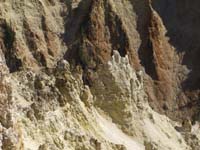 It is a good thing I tooks some of the pictures of the canyon walls out, else you would never get through this page.
It is a good thing I tooks some of the pictures of the canyon walls out, else you would never get through this page.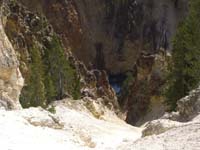 This is looking down at the erosion that is constantly occuring. It would seem that the side walk we were on will not be here for long.
This is looking down at the erosion that is constantly occuring. It would seem that the side walk we were on will not be here for long.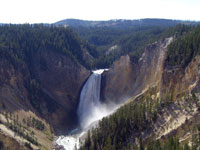 Lower Yellowstone Falls. 308ft drop where an average of 37,000 gallons per second flows over.
Lower Yellowstone Falls. 308ft drop where an average of 37,000 gallons per second flows over.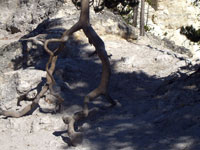 Yes, this tree was still alive.
Yes, this tree was still alive.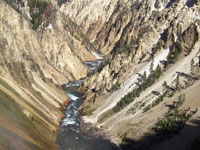 This is looking down the river into the canyon from the top of the falls.
This is looking down the river into the canyon from the top of the falls.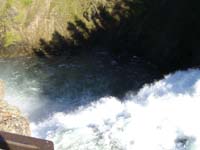 This is looking down at the power the water has as it falls.
This is looking down at the power the water has as it falls.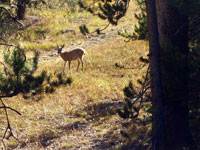 As we headed back to the car to check out the Upper Yellowstone Falls we came across this fawn. Apparently, less then a year old and still has its white spots.
As we headed back to the car to check out the Upper Yellowstone Falls we came across this fawn. Apparently, less then a year old and still has its white spots.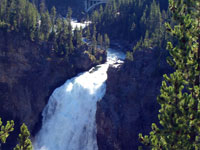 The Upper Yellowstone Falls. It has about a 110ft drop and is probably less then a quarter mile from the Lower Yellowstone Falls.
The Upper Yellowstone Falls. It has about a 110ft drop and is probably less then a quarter mile from the Lower Yellowstone Falls. I like the bridge in this picture.
I like the bridge in this picture.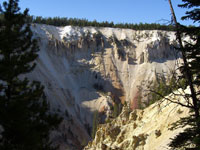 You cannot see it in this picture, but some wildlife was trying to walk on the side of this wall. There are footprints going across the white area.
You cannot see it in this picture, but some wildlife was trying to walk on the side of this wall. There are footprints going across the white area.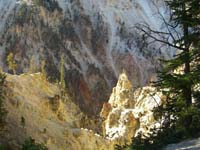 More rock pictures, what can I say, I thought it was really neat looking rock.
More rock pictures, what can I say, I thought it was really neat looking rock.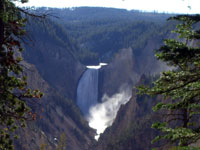 this is a picture from Artist Point looking at the Lower Yellowstone Falls.
this is a picture from Artist Point looking at the Lower Yellowstone Falls.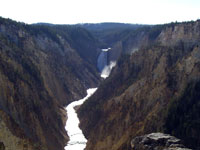 I thought the sun reflecting off the river down in the canyon was a pretty scenic shot.
I thought the sun reflecting off the river down in the canyon was a pretty scenic shot. Yet another picture of the sheer, colored walls of the canyon.
Yet another picture of the sheer, colored walls of the canyon.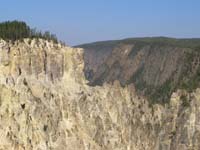 What is this? Another cool rock wall!
What is this? Another cool rock wall!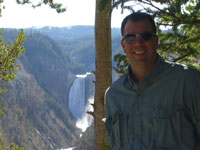 Such a scenic view that I had to get a picture of me in it.
Such a scenic view that I had to get a picture of me in it.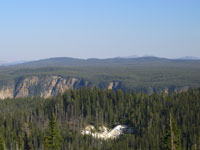 As we began our trek out the park towards the East entrance, we stopped at a pull out to see where the caldera walls started when the area exploded 600,000 years ago.
As we began our trek out the park towards the East entrance, we stopped at a pull out to see where the caldera walls started when the area exploded 600,000 years ago.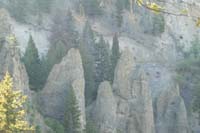 More rock spires.
More rock spires.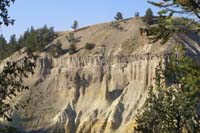 Be sure to look at the larger image of this. Looks like man made columns along the side of this hill.
Be sure to look at the larger image of this. Looks like man made columns along the side of this hill. This squirrell was not happy with us invading his area, so he was dropping pine cones at us. Tom and I seem to attract this kind of attention from squirrels.
This squirrell was not happy with us invading his area, so he was dropping pine cones at us. Tom and I seem to attract this kind of attention from squirrels.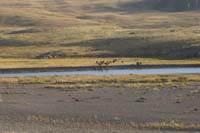 We saw this herd of Bison crossing the river.
We saw this herd of Bison crossing the river.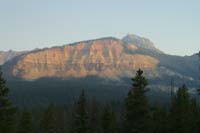 As the sun was going over the horizon, you can see the beautiful colors on this peak. Notice the haze from the smoke of nearby fires.
As the sun was going over the horizon, you can see the beautiful colors on this peak. Notice the haze from the smoke of nearby fires.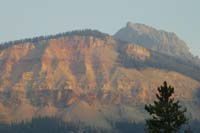 Same colors, same haze, same peak, just closer.
Same colors, same haze, same peak, just closer.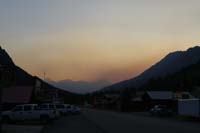 We stopped in the little town of Cook to get a bite to eat and some gas before we headed out on the Beartooth Highway toward Billings, Mt.
We stopped in the little town of Cook to get a bite to eat and some gas before we headed out on the Beartooth Highway toward Billings, Mt. This was one of the most scenic highways I have been on. It would take us a lot longer to get to Billings, but the views were awesome.
This was one of the most scenic highways I have been on. It would take us a lot longer to get to Billings, but the views were awesome.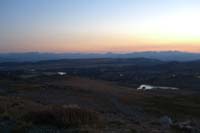 It is too bad that we got here so late in the day, but we did get some good shots of the sunset from the 11,000ft passes we had drive over.
It is too bad that we got here so late in the day, but we did get some good shots of the sunset from the 11,000ft passes we had drive over.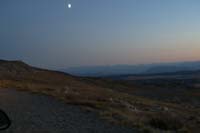 The moon and sunset from 11,000ft. Nice way to end the trip.
The moon and sunset from 11,000ft. Nice way to end the trip.